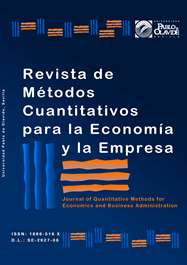Hidden Champions in Spain: The Path to Successful Business Decisions
DOI:
https://doi.org/10.46661/revmetodoscuanteconempresa.2887Keywords:
hidden champion, brand champion, global value chains (GVC), competitiveness, internationalization, cadenas de valor globales (CVG), competitividad, internacionalizaciónAbstract
The last three decades have been a story of lost opportunities for Spanish industry to transform and improve their international competitiveness. However, there are some paradigmatic examples that violate this rule. This is the case of two Spanish companies: Hidden Champions and Brand Champions. These companies behave differently from the European and Spanish ones of similar size. They are more resilient in times of economic recession and are able to maintain and even increase their employment levels, while significantly increasing its sales and added value. This research therefore seeks to ascertain whether the Spanish hidden champions are good indicators of maturity, stability and growth of the Spanish economy; in addition to determining the reasons that have brought success and allowed these companies to recover faster than other firms. To do this, we have considered the quantitative and qualitative results collected by 75 Spanish companies to identify key management decisions. All this information is supplemented by personal interviews in order to capture more qualitative aspects about the nature of companies' management practices.
Downloads
References
AMANN B. & JAUSSAUD J. (2012): “Family and non-family business resilience in an economic downturn”. Asia Pacific Business Review, 18(2), 203-223.
AFEC (2015): Fresh View Special Edition: Austria’s Hidden Champions. Vienna: Austrian Federal Economic Chamber.
BOX, G.E.P.; JENKINS, G.M. & REINSEL, G.C. (1994): Time series analysis. Forecasting and control, 3rd ed. Englewood Cliffs: Prentice Hall.
CEEMAN (2011): Hidden champions in CEE and dynamically changing environments. Research Report. Bled: Central and East European Management Development Association.
CHRISMAN, J.; CHUA J. & STEIER, L. (2011): “Resilience of Family Firms: An Introduction”. Entrepreneurship Theory and Practice, 35(6), 1107-1119.
DRUCKER, P.F. (1988): “The Coming of the New Organization”. Harvard Business Review, 66(1), 45-53
EUROPEAN COMMISSION (2011): SBA fact Countries Sheets. Several issues.
FEUBLI, P. & GACHET, E. (2015): The Hidden Swiss Champions: Small but World Class. Credit Suisse. Available at: https://www.credit-suisse.com/corporate/en/articles/news-and-expertise/the-hidden-swiss-champions-small-but-world-class-201506.html.
FREEL, M.S. & Robson, P.J.A. (2004): “Small Firm Innovation, Growth and Performance: Evidence from Scotland and Northern England”. International Small Business Journal: Researching Entrepreneurship, 22(6), 561-575.
KOTHA, S. (1995): “Mass customization: implementing the emerging paradigm for competitive advantage”. Strategic Management Journal, 16(5), 21-42.
MORENO, F. & COAD, A. (2015): “High-growth firms: Stylized facts and conflicting results”. In A.C. Corbett, J.A. Katz & A. Mckelvie (eds.): Entrepreneurship Growth: Individual, Firm, and Region. Bingley: Emerald Publishing Group, pp. 187-230.
MYRO, R. & GANDOY, R. (2009). “Capítulo 8: Sector industrial”. In J.L. García Delgado & R. Myro (eds.): Lecciones de Economía Española. Madrid: Thomson-Civitas, pp. 96-111.
PORTER, M.E. (1985): Competitive Advantage: Creating and Sustaining Superior Performance. New York: The Free Press.
ROBSON, P.J.A. & BENNETT, R.J. (2000): “SME Growth: The Relationship with Business Advice and External Collaboration”. Small Business Economics, 15(3), pp 193-208.
SCHAEDE, U. (2011): “Show Me the Money: Japan’s Most Profitable Companies in the 2000s”. DBJ Discussion Paper Series, 1211. Available at: http://www.dbj.jp/ricf/pdf/research/DBJ_DP_1211.pdf.
SIMON, H. (1990): “Speerspitze der deutschen Wirtschaft”. Zeitschrift für Betriebswirtschaft, 60(9), 875-890.
SIMON, H. (1996): Hidden Champions: Lessons from 500 of World’s Best Unknown Companies. Boston: Harvard Business School Press.
SIMON, H. (2009): Hidden Champions of the 21st Century: Success Strategies of Unknown World Market Leaders. London: Springer.
VENOHR, B. & MEYER, K. (2007). “The German miracle keeps running: How Germany’s hidden Champions Stay Ahead in the Global Economy”. Working Papers of Institute of Management Berlin at Berlin School of Economics, 30. Available at: http://hwr-berlin.com/fileadmin/downloads_internet/Forschung/Veroeffentlichungen/Working_paper/working_paper_30.pdf.
VERNON, R. (1966): “International investment and international trade in the product cycle”. Quarterly Journal of Economics, 80(2), 190-207.
VOUDOURIS, I.; LIOUKAS, S.; MAKRIDAKIS, S. & SPANOS, Y. (2000): “Greek Hidden Champions: Lessons from Small Little-Known Firms in Greece”. European Management Journal, 18(6), 663-674.
Downloads
Published
How to Cite
Issue
Section
License
Copyright (c) 2017 Journal of Quantitative Methods for Economics and Business Administration

This work is licensed under a Creative Commons Attribution-ShareAlike 4.0 International License.
Submission of manuscripts implies that the work described has not been published before (except in the form of an abstract or as part of thesis), that it is not under consideration for publication elsewhere and that, in case of acceptance, the authors agree to automatic transfer of the copyright to the Journal for its publication and dissemination. Authors retain the authors' right to use and share the article according to a personal or instutional use or scholarly sharing purposes; in addition, they retain patent, trademark and other intellectual property rights (including research data).
All the articles are published in the Journal under the Creative Commons license CC-BY-SA (Attribution-ShareAlike). It is allowed a commercial use of the work (always including the author attribution) and other derivative works, which must be released under the same license as the original work.
Up to Volume 21, this Journal has been licensing the articles under the Creative Commons license CC-BY-SA 3.0 ES. Starting from Volume 22, the Creative Commons license CC-BY-SA 4.0 is used.










